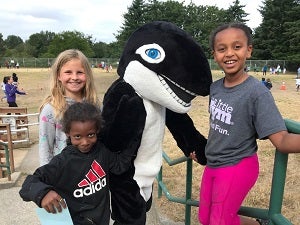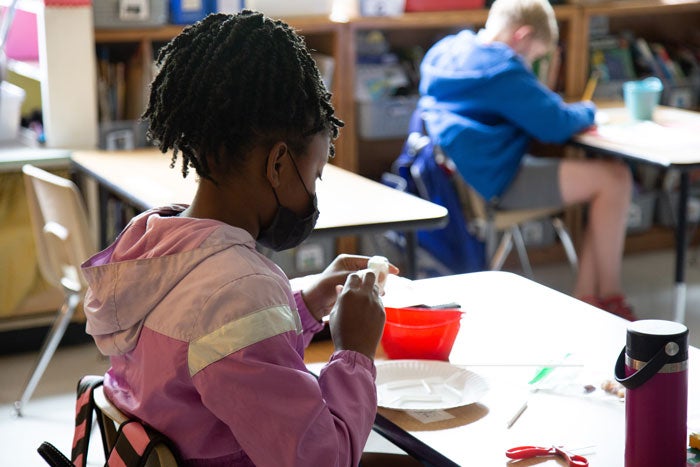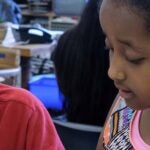4th Grade
A Family Guide to 4th Grade
In every grade, SPS’ core work is supporting student learning. We believe it is our responsibility to do whatever it takes to ensure that every child, regardless of race, gender, socioeconomic status, language proficiency, learning style or disability, achieves to their highest level.
Fourth grade is a time for growth! Your child is beginning to develop the skills to manage and initiate their own learning, and you may be surprised by the new interests they discover.
To support learning, it is helpful to ask open-ended questions, the kind that cannot be answered by “yes” or “no.”
Fourth graders are often eager to show what they know, so encourage your child to describe what they are doing in class through drawing, writing or demonstrating new skills or ideas, as well as talking about them.
Your child’s teachers can help you understand more about the topics that interest or challenge them, and you can share about their habits. Do they like to move around, be part of a group, or have a quiet space when they read or study? Do they like competition or do they work better without pressure?
Important Dates
September
- 1st day of school
November
- Parent-Teacher Conferences
December
- End of 1st Trimester; 1st Progress Report Available
March
- End of 2nd Trimester; 2nd Progress Report Available
June
- End of 3rd Trimester; 3rd Progress Report Available
Student Progress Reports
The clear learning standards in the report card may help your 4th grader. Children this age can make plans and connections, think deeply, and understand more complex ideas. They can talk with you about why they are or are not meeting expectations in each area, and you can challenge them to think about how they can improve their skills. By sharing ideas, teachers and families discover new ways to motivate learning.
Teachers and families should pay attention to social-emotional skills and learning readiness expectations and understand academic goals in language arts, math, science, social studies, physical education and arts. Fourth graders who see what they need to know and feel confident and supported will make progress!
How to Access Progress Reports
Families will use The Source to view Student Progress Reports.
Parent and guardians can create an account with the email on record at their student’s school.
Student Success by Subject
Social Emotional Learning
At Seattle Public Schools we believe that social emotional learning prepares students for learning and life.

Social emotional learning (SEL) helps children:
• Manage emotions, show empathy
• Develop a healthy identity
• Make responsible decisions
• Have positive relationships
• Contribute to their community
These skills are important for learning and life.
At school, students learn and practice SEL skills throughout the day.
Reading and Writing
In English language arts (ELA), 4th grade students learn to:
- Independently read different types, or genres, of writing
- Summarize their reading
- Find the main idea and share details from the text to support their thinking
- Think about a character’s actions and how they impact the story
- Read and comprehend grade-level texts accurately and fluently, figuring out the meaning of unknown words
- Write about their opinions or information with facts and details
- Work to plan and edit to make writing clearer and more organized
- Write for different purposes and audiences
- Take part in collaborative classroom conversations
Encourage your child to read 20 minutes or more every day.
Math

In 4th grade math, students will build on their 3rd grade understanding of the base-10 number system, multiplication, and fractions to:
- Understand and use properties of the four operations to solve single and multistep problems involving whole numbers
- Demonstrate understanding of place value for multi-digit whole numbers
- Multiply multi-digit numbers using place value understanding and properties of operations
- Divide multi-digit numbers by single digit numbers using place value understanding, properties of operations, and the inverse relationship between multiplication and division
- Fluently add and subtract within 1,000,000
- Understand fraction equivalence and use it to compare fractions
- Build fractions from unit fractions (i.e., 1/3, 1/4, 1/8) using addition and multiplication
- Multiply a fraction by a whole number
- Use decimal notation for fractions with denominators of 10 or 100
- Compare two decimals to the hundredths place
- Solve problems involving measurement including conversion from a larger unit to a smaller unit
- Understand concept of angle and measure angles
We believe all students have mathematical brilliance. Your child’s teacher seeks to cultivate brilliance to develop your child into a mathematical thinker and problem solver. Your child will see who sees the value of math in their life.
Science
What are 3rd graders learning in science?
This is a time for transition in science education, with teaching and learning focused on three key areas in Washington state Science Learning Standards:
- Science/engineering practices used by professionals to explain the world or solve problems
- Core ideas that include fundamental scientific knowledge
- Crosscutting concepts frame scientific thinking across life, earth/space, physical sciences.
Your child’s report card shows performance expectations, for what students should be able to do by the end of a unit. The three dimensions are woven into each performance expectation.
Get outside together, taking time to notice, appreciate, and wonder about the natural world.
Social Studies
What’s important about 4th grade social studies?
The report card shows five areas of social studies that you and your child can discuss.
- Civics – Understanding how governments are organized into levels; rights and responsibilities in the WA State Constitution
- Economics – Understanding WA State economy, environment, and population
- Geography – Understanding physical and
- cultural characteristics of Pacific Northwest
- History – Using multiple perspectives to learn about Washington State history
- Social Studies Skills – using questions and multiple sources to find information, and make conclusions
Physical Education
In physical education (PE), students build movement skills, knowledge, fitness, social well being, and confidence so they can enjoy a healthy, active lifestyle. Seattle Public Schools is committed to providing a quality physical education program to help students develop in these areas.
Our PE standards are based on motor and movement patterns and skills, as well as concepts like physical literacy, which is the ability, confidence, and desire to be physically active for life. PE is an instructional program, which makes it different from recess, free play, recreational sports, or athletics.
PE teachers work with general education teachers to provide high quality instruction for an average of 100 minutes per week, which is required by Washington state law. Schools organize PE times in different ways, but all students should be learning about their physical selves all year long!
Visual and Performing Arts
Research shows that students with an arts education are more engaged, do better in school, and are more likely to graduate and participate in community life. In Seattle Public Schools, we want every student to receive a comprehensive, predictable arts education during their K-12 years.
Each elementary school offers different arts programs, from possibilities including visual arts, general music, theatre, dance, or instrumental music.
Progress report standards come from the Washington state Arts Learning Standards, which focus on aspects of artistic process:
- Creating: developing new artistic ideas and work.
- Performing: interpreting and presenting artistic ideas / work
- Responding: understanding and evaluating meaning in the arts
- Connecting: Relating personally to artistic ideas and work
The arts are a core subject!
Make art together!

